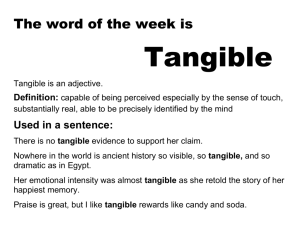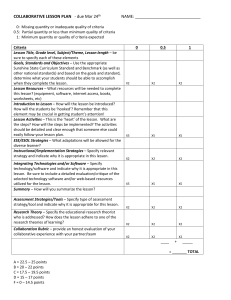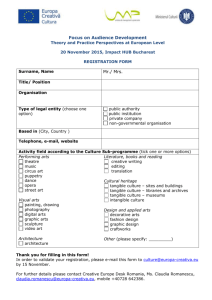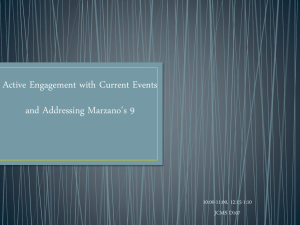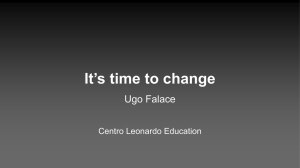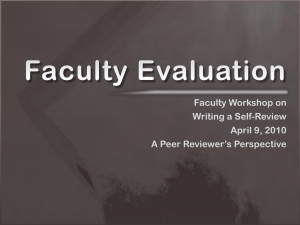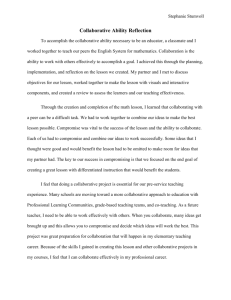Emergent themes for collaborative interaction
advertisement
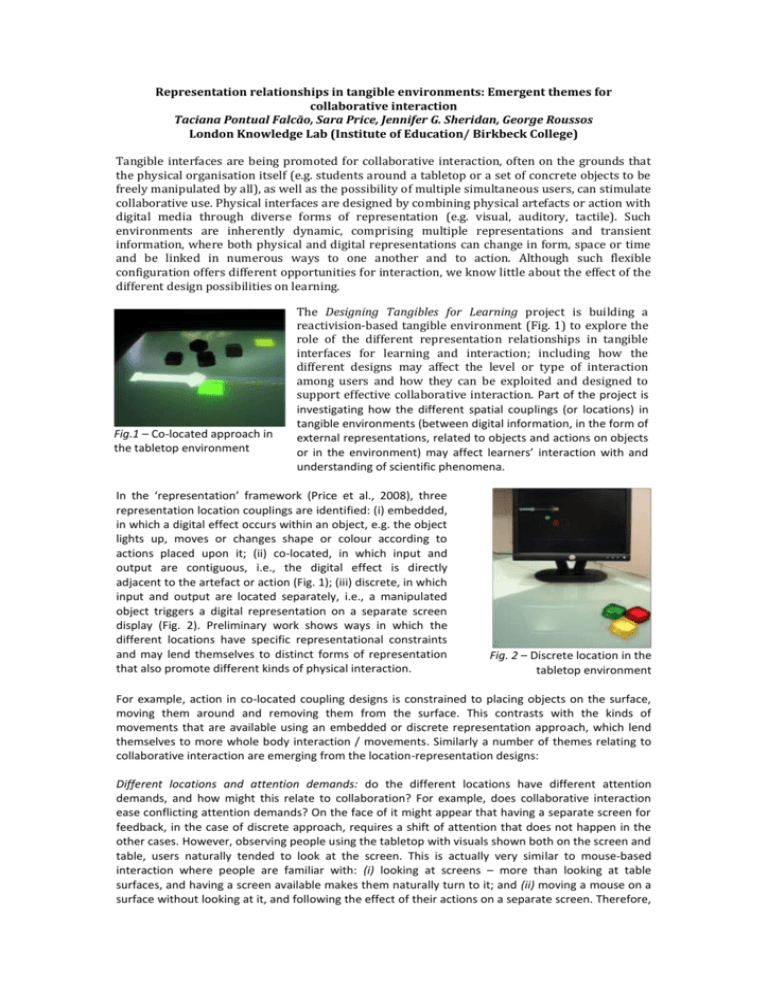
Representation relationships in tangible environments: Emergent themes for collaborative interaction Taciana Pontual Falcão, Sara Price, Jennifer G. Sheridan, George Roussos London Knowledge Lab (Institute of Education/ Birkbeck College) Tangible interfaces are being promoted for collaborative interaction, often on the grounds that the physical organisation itself (e.g. students around a tabletop or a set of concrete objects to be freely manipulated by all), as well as the possibility of multiple simultaneous users, can stimulate collaborative use. Physical interfaces are designed by combining physical artefacts or action with digital media through diverse forms of representation (e.g. visual, auditory, tactile). Such environments are inherently dynamic, comprising multiple representations and transient information, where both physical and digital representations can change in form, space or time and be linked in numerous ways to one another and to action. Although such flexible configuration offers different opportunities for interaction, we know little about the effect of the different design possibilities on learning. Fig.1 – Co-located approach in the tabletop environment The Designing Tangibles for Learning project is building a reactivision-based tangible environment (Fig. 1) to explore the role of the different representation relationships in tangible interfaces for learning and interaction; including how the different designs may affect the level or type of interaction among users and how they can be exploited and designed to support effective collaborative interaction. Part of the project is investigating how the different spatial couplings (or locations) in tangible environments (between digital information, in the form of external representations, related to objects and actions on objects or in the environment) may affect learners’ interaction with and understanding of scientific phenomena. In the ‘representation’ framework (Price et al., 2008), three representation location couplings are identified: (i) embedded, in which a digital effect occurs within an object, e.g. the object lights up, moves or changes shape or colour according to actions placed upon it; (ii) co-located, in which input and output are contiguous, i.e., the digital effect is directly adjacent to the artefact or action (Fig. 1); (iii) discrete, in which input and output are located separately, i.e., a manipulated object triggers a digital representation on a separate screen display (Fig. 2). Preliminary work shows ways in which the different locations have specific representational constraints and may lend themselves to distinct forms of representation that also promote different kinds of physical interaction. Fig. 2 – Discrete location in the tabletop environment For example, action in co-located coupling designs is constrained to placing objects on the surface, moving them around and removing them from the surface. This contrasts with the kinds of movements that are available using an embedded or discrete representation approach, which lend themselves to more whole body interaction / movements. Similarly a number of themes relating to collaborative interaction are emerging from the location-representation designs: Different locations and attention demands: do the different locations have different attention demands, and how might this relate to collaboration? For example, does collaborative interaction ease conflicting attention demands? On the face of it might appear that having a separate screen for feedback, in the case of discrete approach, requires a shift of attention that does not happen in the other cases. However, observing people using the tabletop with visuals shown both on the screen and table, users naturally tended to look at the screen. This is actually very similar to mouse-based interaction where people are familiar with: (i) looking at screens – more than looking at table surfaces, and having a screen available makes them naturally turn to it; and (ii) moving a mouse on a surface without looking at it, and following the effect of their actions on a separate screen. Therefore, people do not necessarily find it difficult, or unusual to move objects on a surface and have the system’s feedback on a separate screen. The collaborative focus again becomes the screen. On the other hand, when users’ attention is directed to the table surface, users clearly see each others’ actions while looking at the surface for the system’s feedback. The opportunity this provides for users to give opinions on, and even interfere in, others’ actions, changes the nature of the collaboration. When looking at a separate screen, users may more easily lose track of each other, and tend to work by themselves. Combined representation location and levels of abstraction: How does design of representations in multiple locations affect collaboration? In terms of representation design preliminary work suggests that the location relationships between artefact and digital representation lend themselves to representing at different levels of abstraction. For example, an embedded representation is consistent with depicting a ‘central’ effect related to the object/action, while a co-located representation is consistent with a ‘local’ effect and discrete can illustrate more global effects of the same phenomena. Combined digital augmentation in these locations offers the possibility of representing phenomena at different levels of abstraction at the same time. How might this affect collaborative interaction? Do collaborators notice different events and share their understanding across representations? Representation transience and collaborative exploration: the transient nature of representations in many tangible interfaces means that users do not create ‘permanent marks’ (Blackwell, 2003), i.e. meaning is conveyed by the sequence of actions performed by users on the objects, and not by some final spatial arrangement alone. This means decreasing the pressure for ‘correct answers’ and allowing students to explore the interface regardless of ‘mistakes’, testing different possibilities that do not necessarily represent a solution based on which they will be assessed. Introduction of concrete objects in a task-solving session on fractions was shown to have a great impact on students’ collaboration (Pontual Falcão, 2007), as children started to interact when given physical resources to help them reflecting, while up to that point they had been quiet to avoid wrong answers. Meaning-making: Collaboration can also be affected by other aspects of representations. When designing an augmented-reality learning environment, Randell et al. (2004) showed that representations with more ambiguous mappings promoted higher levels of collaborative reflection through discussion than direct mappings. The precision of information to be offered by a representation is a matter for debate. Ambiguity can be an opportunity for subjective interpretation and meaning-making, as long as it does not negatively interfere in the accomplishment of welldefined tasks. Ambiguous representations can be evocative rather than didactic and mysterious rather than obvious (Gaver, 2003). The ‘mystery’ involved in somehow unclear representations may lead to discovery through exploration, and make students rely on each other to reach a conclusion. How does this meaning-making occur in collaborative contexts? The diversity of technologies, representational media and flexible linking inherent in tangible environments may support different kinds of collaboration, particularly through the opportunities offered for physical, gestural and verbal interactions. References Blackwell, A. (2003) Cognitive Dimensions of Tangible Programming Languages. In: Proceedings of the First Joint Conference of EASE and PPIG 2003, pp. 391-405. Gaver, B., Beaver, J. and Benford, S. (2003) Ambiguity as a resource for design. In Bellotti, V., Erickson, T., et al. (eds) Proceedings of CHI 2003, ACM Press. Pontual Falcão, T. (2007) Design de interfaces tangíveis para aprendizagem de conceitos matemáticos no Ensino Fundamental. Master’s thesis, Federal University of Pernambuco, Brazil. Price, S., Sheridan, J., Pontual Falcão, T., Roussos, G. (in press) Towards a framework for investigating tangible environments for learning. IJART Special Issue on Tangible and Embedded Interaction 2008. Randell, C., Price, S., Rogers, Y., Harris. E., and Fitzpatrick, G. (2004) The Ambient Horn: Designing a novel audio-based learning experience. Personal and Ubiquitous Computing, 8, 3, 144-161.

